
Plague Quarantine Page Menu: 1 2 3 4 5 6 7 8 9 10 11 12 13 14 15 Next>>
Golden Age of Piracy Maritime Quarantine For Plague, Page 10
The Mediterranean Lazarettos
The Mediterranean lazarettos used to process incoming ships were built like fortresses.
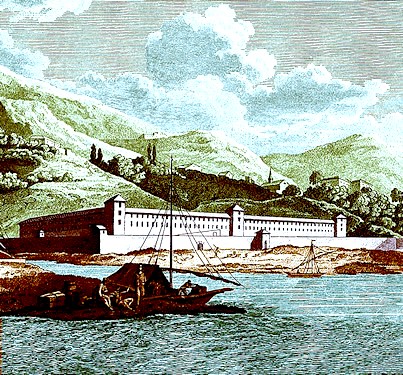
Genoa Lazaretto, From An account of the principal Lazarettos in Europe,
By John Howard, From the Wellcome Collection (1789)
"Externally, the lazaretto is like an almost blind wall, reinforced in some cases with towers as in Marseille, Genoa, Livorno, Mahon or Corfu."1 They were "divided into several sectors that are carefully separated from one another. ...These enclosures include a more or less extensive courtyard, provided with a fountain of running water, and covered buildings. These are arranged on the periphery of the court as in Genoa, ...Livorno and Malta, or in the middle of it, which is the case at Trieste, Venice and Marseilles."2 Goods were housed in warehouses which were generally tall and roofed with open sides to allow for free passage of the air. Passengers were housed in small rooms which were carefully separated from both the goods warehouses and the other passengers.
There were several port-based lazarettos for quarantining incoming ships in the Mediterranean during the golden age of piracy. As seen in previous sections, there is more information available about some than there is about others. Certain lazarettos appear in some of the English accounts of life at sea from around this period including Venice, Livorno and Naples in Italy, Zankythos in Greece, Malta, Marseille in France and Alicante in Spain. These, along with a few other locations which sailors mention as being sites of quarantine and pratique during this period are the focus of this section.
1,2 Daniel Panzac, Quarantines et Lazarets, 1986, p. 38 - interpreted by the author;
The Mediterranean Lazarettos - Venice
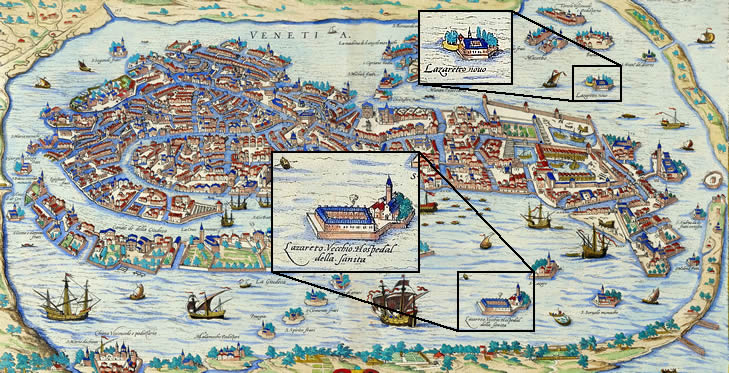 A Map of Venice Highlighting the Locations of Lazaretto Vecchio and Lazaretto Nuovo (1572) |
Much of the history of the two primary Venice lazarettos - Lazaretto Nuovo ('new lazaretto') and Lazaretto Vecchio ('old lazaretto') - has already been discussed in some detail in previous sections. As prison reformer and lazaretto researcher John Howard's account of quarantine in 1789 reveal, the Lazaretto Nuovo was where people coming in on a ship with an infected/foul status were sent. Those people and ships which were assigned suspect status were sent to the Lazaretto Vecchio.1 Medical historian Guenter Risse similarly says the new lazaretto was built
Photo: Wiki User Powermelon - Lazaretto Vecchio Entrance, 2015
"to house sospetti [suspect patients] taken from a victim's house, as well as convalescents from Lazzaretto Vecchio who were required to spend an additional forty days before being allowed to return to Venice."2 Howard found himself not altogether pleased with the quality of his quarters at the new lazaretto when he served quarantine there, so he got himself transferred to the old lazaretto. (He did not find the old lazarettos quarters to be that much of an improvement.)
The site of first purpose-built Venetian lazaretto was the Island of Santa Maria located in the central lagoon of Venice on the opposite side of St Mark’s Basin.3 The island, which covers 2.53 hectares (6.3 acres), was taken from the monks of St. Agostino in 1403 to house those suffering from the plague as well as to quarantine sailors and passengers coming into Venice from suspected locations.4 The Senate of the Serenissima Republic decided to build a hospital there in 1423 for the treatment of plague-infected people. "During the 1430s, the Lazzaretto Vecchio became an accepted institution to house the sick, expanding its staff to include a priest, male and female servants, boatmen and gravediggers."5 The island was gradually enlarged by reclaiming the surrounding mud flats, which accounts for its unusual geometric shape.6
Lazaretto Nuovo was built on the Island of Vigna Murata (originally owned by the Benedictine monks of San Giorgio Maggiore) located near the entry of the Lagoon 3 Km (1.8 miles)
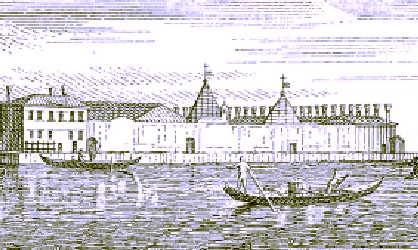
Artist: Antonio Visentini - Isola del Lazzaretto Nuovo, (1777)
to the north-east of Venice. Its construction was decreed by Senate of Serenissima in 1468. The island became a place for quarantining ships arriving from Mediterranean ports which were suspected to be plague-infected. To improve the efficiency of the health care setting, several new structures were built on the island. "In 1576, Francesco Sansovino says, it had 'a hundred rooms and by far has the semblance of a castle'. This appearance is due to the nearly one hundred Venetian chimneys of the cells (“rooms”), located near the boundary wall. In the inner spaces large sheds (“Teze”) were built for the cleaning of the goods: they used mostly smoke of aromatic herbs such as juniper and rosemary."7
Howard explains that both of the lazarettos were protected from outside interference by high walls and broad canals. He gives a fairly detailed general description of them:
Photo: Wiki User Powermelon - Lazaretto Vecchio Buildings in 2015
They have only a ground floor and one over it, and are divided and subdivided into a great number of apartments, greater and smaller, for the reception of passengers; all these apartments have their separate entries and stairs, and every range of them has an open court in front, with plats of grass which is not suffered to grow too high, and no kind of trees or vegetables are permitted within this district, nor within a good distance from it. There are sheds against some of the walls, and in other proper places (but not mixed with the apartments of passengers) so contrived that the merchandise is not exposed to damage by rain or otherwise, and at the same time, that the air is not confined.8
As already mentioned, each of the two main lazarettos appear in Howard's account of the quarantine he served in Venice. Land-based surgeon Samuel Sharp all provided an account of it when he visited it in 1765, although he did not actually serve quarantine there. However, none of the period sailors' account give much notice to it. Unlike some of the other lazarettos which were located along the way to other destinations of English ships, Venice was a destination which may be why it doesn't appear as often as some of the other lazarettos during this period.
Still, the Venetian lazaretto system (which included several other lazarettos in the Ionian Islands) was the model for others and may be one of the better examples of the use of lazarettos, given that the plague last hit Venice in 1630.9
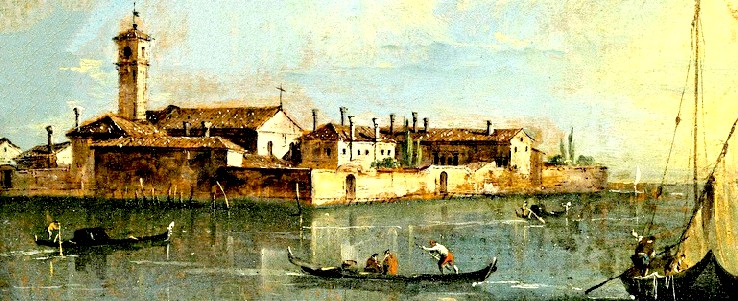 Artist: Francesco Guardi - The Island of Lazaretto Vecchio, Venice (18th Century) |
1 John Howard, An Account of the Principal Lazarettos In Europe, 1791, p. 11; 2 Guenter B. Risse, Seventeenth-Century Pest Houses or Lazarettos, Jan. 1999, p. 27; 3 “Lazzaretto Vecchio: History”, http://www.lazzarettovecchio.it, gathered 4/15/19; 4 John Macauley Eager, "The early history of quarantine", Yellow Fever Institute Bulletin No. 12, March, 1903, p. 17; 5 Risse, p. 26; 6 “Lazzaretto Vecchio: History”, gathered 4/15/19; 7 “Lazzaretto Nuovo Through The Centuries And Today”, www.lazzarettonuovo.com, gathered 6/21/18; 8 Howard, p. 13; 9 Katerina Konstantinidou et al, "Venetian Rule and Control of Plague Epidemics on the Ionian Islands during 17th and 18th Centuries," Emerging Infectious Diseases, Vol. 15, No. 1, Jan 2009, p. 40
The Mediterranean Lazarettos - The Greek Lazarettos
The Greek lazarettos were actually a part of the Venetian lazaretto system.
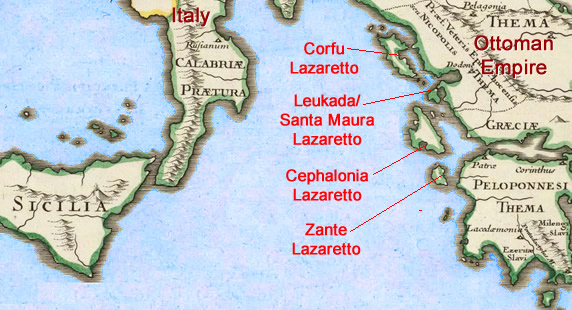
Ionian Lazaretto Locations - Map: From Imperii Orientalis et Circumjacentium Regionum, by Anselmo Banduri (1715)
Following the Fourth Crusade (1204), Venice managed to take control of some Greek coastal cities as well as the islands in the Ionian Sea. "The islands of Corfu (Greek name Kerkyra), Zante (Zakynthos), Cephalonia, and Leukada were incorporated into the Venetian State in 1386, 1485, 1502, and 1684, respectively, and remained part of it until its demise in 1797."1 Each of these four islands had a lazaretto which was active during the golden age of piracy.
There was also an important lazaretto in Crete (not shown on the map) referred to in Venetian documents as Monasterium Sancti Lazzari, Monasterium infermorum Sancti Lazzari, Ospedal delli infermi de San Lazzaro, or more broadly San Lazzaro. However, the existence and use of this lazaretto during the golden age of piracy seems unlikely. On the one hand, Dimitrios Anoyatis-Pele explains that "the building was not depicted in the Ottoman plans of siege (1648-1669), thus advocating the
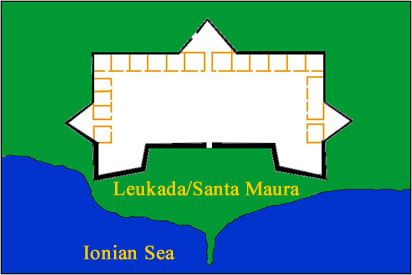
Leukada/Santa Maura Lazaretto Plan, Based on Venetian Archives Plan
theory that the building had been destroyed by the start of the siege [in 1648]."2 However, he also notes that it shows up on maps which were drawn in 1645, 1660, 1666 and 1668-1669.3 It is never mentioned by any of the sailors accounts under study.
Of the four other island-based lazarettos, the most important in this article was the one at Zante, being the only lazaretto mentioned in the sailor's accounts from around the golden age of piracy. However, since they were all part of the same system, the history of the other lazarettos used during this period will also be discussed briefly. Little is recorded about one of these - the lazaretto which was at Leukada or Santa Maura (today called Lefkada) - other than it was built in 1718.4 Like some of the other Ionian lazarettos constructed by Venice, its primary purpose appears to have been to prevent local outbreaks from ships delivering goods to that island or people travelling locally to trade and work.
The lazaretto at Cephalonia (today called Kefalonia) was constructed in 1705 in
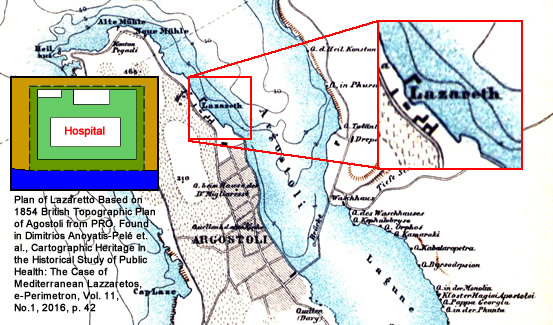
Cephlonian Lazaretto at Argostoli With Plan, From Die Bucht von Agostoli, By Carle Wiebel, p183 (1873)
the capital city of the island, Argostoli.5 It was renovated during the golden age of piracy in 1719.6 Plague only struck Cephalonia twice - once before the GAoP in 1646 (before the construction of the lazaretto) and once afterwards in 1760.7Simonetta Cavaciocchi suggests that that this "is easily explained by the lack of urban centers or highly frequented ports [on Cephalonia]; on the other hand, its geographical significance, with the great mountain ranges, prevented the expansion of the disease in the area."8
There is not much information to be found concerning this lazaretto, particularly during the golden age of piracy. From the inset plan of the structure seen in the image above, 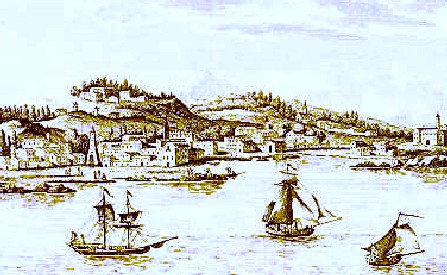
The Port of Argostoli (Before 1757)
it is a small structure when compared with the other Ionian lazarettos. Writing about his experience of the lazaretto in 1828, Reverend Joseph Wolff said "On our arrival at Argostoli we were obliged to perform twenty-five days' quarantine in a most miserable and dirty Lazaretto"9. A handbook printed for British travelers in the area in 1845 differed, stated: "The lazaretto [at Cephalonia] is good, and in a healthy situation near the barracks."10 Given the facts that these two entries are very brief and the lazaretto had undergone at least two renovations (1791 and 1841) after the period of interest, their value here is admittedly limited. However, they again suggest that the Cephalonian lazaretto was primarily used at that period to quarantine people visiting the island. Cavaciocchi comments that the island was "poor and far from the commercial networks of the area"11.
The Corfu lazaretto was originally established in 1588 by a Venetian Board of
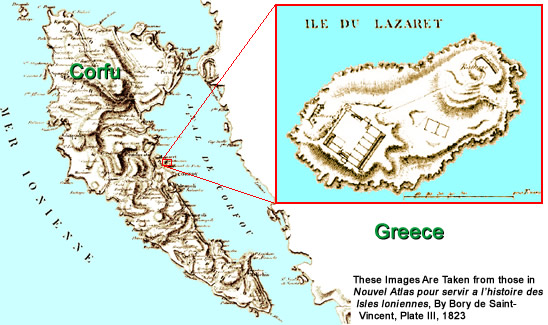
Corfu with Detail of the Island of Saint Demetrius (1823)
Health. It was built on the small island Saint Demetrius (Aghios Dimitrios) which is located near the entrance of the harbor, north-west of the city of Corfu. This lazaretto was built "to promote trade, precisely in the period in which the Levant Company appeared on the Mediterranean horizon."12 The Levant Company was chartered in England, giving it the exclusive right to trade there as a result of a 1580 treaty signed by England and the Ottoman empire. The timing suggests that the Corfu and Zante lazarettos were established to protect the Venetian holdings from ships trading with the Ottomans. Corfu was an important port for the Venetians during the golden age of piracy. It was the headquarters for the naval base of the Stato da Màr (the overseas possessions of Venice) in addition to being the starting point for Venice's merchant convoys to Constantinople, Cyprus and Alexandria. The local gentry also had a vested interest in protecting Corfu from the plague because the island was an important olive growing center.13
The plague struck Corfu four times: 1611, 1630, 1648, and 1673.14 John Howard
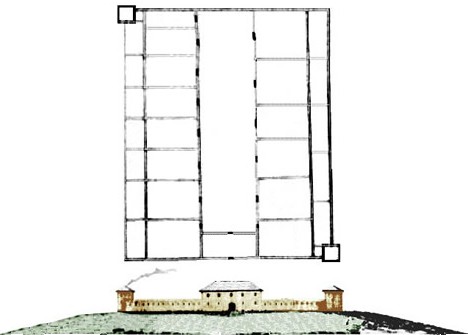
Corfu Lazaretto Plan c. 1705, Based on Image From Venice Archives
mentions the lazaretto in his 1789 book, although he says that he wasn't able to visit it. As a result, his description is terse: "The lazaretto at Corfu is finely situated on a rock surrounded with water, about a league from the city."15 Based on recent satellite images of the island, there is currently a building in a location near to the area where the lazaretto building is shown in the 1823 map seen above. However, that is not the same structure because it in a slightly different place and is nowhere near as large as that shown on the 1823 map. Even the lazaretto shown in that map is not entirely correct for the golden age of piracy. The original lazaretto there suffered earthquake damage in both 1743 and 1786 resulting in it being renovated in 1814 when the British were in control of the Ionian islands.16 A more accurate representation of the lazaretto which existed in Corfu is seen in the 1705 lazaretto plan seen at right.
Based on John Howard's description of the lazaretto at Zante, the quarters for those being quarantined at Corfu were located on one side of the building while the merchandise was placed on the other. The people’s quarters were along the edge with courtyards in front of them which opened into a central, common courtyard, all features seen in the image of the Corfu lazaretto. The two corner towers may have been for the guardians and/or may have been used to purify mail. (Note the smoke in the front view of the lazaretto coming from one of them in the image at the bottom.) The small rectangle at the bottom of the floor plan is the Prior's quarters.
Zante (today called Zakynthos) is the only lazaretto mentioned in the sailor's documents under study. It was established in 1588 by the Venetians.17 Like the Corfu lazaretto, the Zante lazaretto was originally built when the English Levant Company was organized with an eye towards encouraging trade.18 The lazaretto was expanded shortly after the
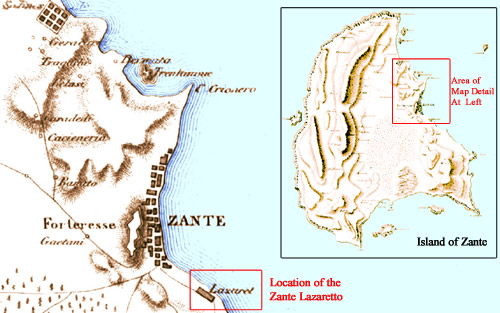
Zante Lazaretto, From Nouvel Atlas pour servir a l histoire des Isles Ioniennes,
By
Bory de Saint-Vincent (1823)
golden age of piracy in 1735. In addition to it, a 'seasonal lazaretto' was built 'on a rock' which was to be used "to house the villagers who went to the Peloponnesia each year for the grain harvest" for their personal use.19 However, this second lazaretto was not used to house maritime trade nor did it exist during the period of interest.
The plague struck Zante in 1617, 1646, 1692, and 1728.20 Simonetta Cavaciocchi mentions that the plague was also present in 1689, when "several cases of pest were isolated in the Zante hospital without consequence."21 However, a ship containing silk from the Island of Milos landed in November of 1689 which was to lead to an outbreak that lasted until December of 1691 leading to 660 reported deaths.
The leadership structure of the Zante lazaretto underwent important changes during the golden age of piracy because of problems with the local authorities who were oversaw quarantine.
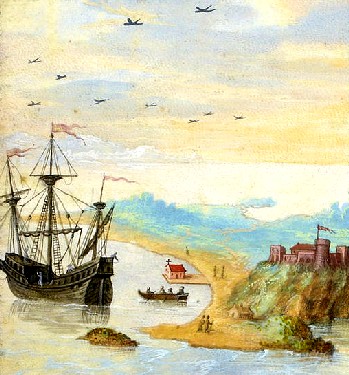
Zante Harbor 16th Century, From Voyages et aventures de Charles
Magius,
Bibliotheque Nationale de France (1578)
The prior in charge of the lazaretto was originally supposed to be appointed by the Venetian Board of Health to serve a four year term. "In reality, during the seventeenth century this office was eventually appointed by grace or sold."22 By the beginning of the 18th century, a local family had managed to maintain control of the lazaretto and its quarantine policy for almost a century. Not surprisingly, the priorities of the family sometimes differed from those established by the Board of Health. As a result, Venice created new regulations for the office of the priors in the Ionian Sea. The new regulations changed the prior's position so that he served a term of four to eight years after which he was eligible for re-appointment. The prior was also made an employee of Venice Board of Health rather than the local health authorities.
John Howard describes the process at Zante, although his description occurred after both the change in rules in 1726 and the expansion of the lazaretto in 1735. He says that the local Zante health office was located waterside so that depositions could be easily taken from ship's captains when they arrived. Three men manned the office. "If they [ships] come from the Levant, or from the Barbary coast, they perform forty-two days quarantine, if from the Morea, only twenty-one days; if from any other part, they and the passengers are generally permitted to pass through the office into the city, as I did when I arrived here from Malta."23
Of the lazaretto itself, Howard explains that it was located about a half mile

Zante Lazaretto Plan, 18th Century, Based on Image From Venice Archives
The 'Old' Lazaretto is Colored Pink While the 'New' Lazaretto Expansion is In Blue.
The Prior's Quarters Are at the
Main
Entrance to the Old Lazaretto Shown in Dark Pink.
from the city on high ground near the Ionian sea. "The entrance is by a covered gate-way ten feet wide, and convenient for the admission of packages. On one side there is a room for the guard consisting of a corporal and four soldiers, on the other, a room for the sub-prior."24 He provides a fairly good explanation of the Old Lazaretto:
Between the outer and inner-gate one of the guards at night commands the middle court, the gate into it being palisaded. This court is about one hundred and thirty feet long and thirty-five wide. The doors of the other courts (three on each side) open into this. On one side they are chiefly designed for passengers, and in each there are four rooms, one of which having a fire-place is called the kitchen. On the other side there are large, deep, open sheds for goods, with a Partition wall. In each of these courts there is a well of water.25
Levant Company chaplain William Biddolph mentions the quarantine procedures on his voyage taken in the first decade of the seventeenth century. He reported that "some of our companie who had businesse there, we sent to the Lazaretta, which is a place like unto the pest house in More-fields, where, though they be in health, yet there they must stay so long as it pleaseth the Signiors of health,
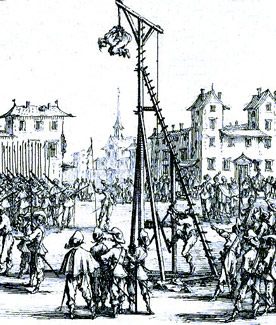
A Man Being Strappadoed, From The Misieries of
War, By Jacques Callot (1633
which is sometime twenty, and sometimes forty dayes: and in the meane time, if any of their companie fall sicke, though it be at the end of fortie daies, yet must they stay forty daies longer."26 Biddolph specifically notes the requirement for a clean bill of health by the Board of Health.
Writing about a voyage taken in 1610 that stopped at Zante, John Sandys similarly explains that pratique there was "a custome strictly observed (as also elsewhere within the Straights belonging to the Christians) not to suffer any to traffick, or come ashore, before they have a Prattick from the Signiors of Health: which will not be granted untill forty days after their arrivall, especially if the ship come from Turkie, and bring not a certificate, that the place from whence they came is free from the infestion"27.
As seems to have been common in earlier periods, both mention the danger of failing to follow quarantine rules. Sandys warns that "it being death to him that shall come ashore without licence [a bill of health]."28 Biddloph likewose states that "whosoever presumeth to come on shoare without Pratticke, is in danger of hanging, or having the strappado."29 Strappadoing requires tying the victim's hands behind their back and being suspended by a rope attached to their wrists, something which often caused dislocation of the shoulders.
1 Katerina Konstantinidou et al, Venetian Rule and Control of Plague Epidemics on the Ionian Islands during 17th and 18th Centuries, Emerging Infectious Diseases Vol. 15, No. 1, Jan 2009, p. 40; 2 Dimitrios Anoyatis-Pele, Ioanna Athanasopoulou, Costas Tsiami, Cartographic Heritage in the Historical Study of Public Health-The Case of Mediterranean Lazzaretos, e-Perimetron, Vol 11, No 1, 2016, p. 37; 3 Anoyatis-Pele et al., p. 39; 4 Simonetta Cavaciocchi, Economic and biological interactions in Pre-industrial Europe, from the 13th to the 18th Centuries, 2009, p. 131, translated by the author; 5 Anoyatis-Pele et al., p. 40; 6 Costas Tsiami, Eleni Thalassinou, Effie Poulakou-Rebelakou and Angelos Hatzakis, "Quarantine and Britsh 'protection' of the Ionian Islands, 1815-64", Mediterranean quarantines, 1750-1914: Space, identity and power, John Ciroop & Francisco Javier Martinez, eds., 2018, p. 261; 7 Konstantinidou et al, p. 41; 8 Cavaciocchi, p. 132; 9 Joseph Wolff, Journal of the Rev. Josepf Wolff, 1839, p. 108; 10 John Murray, A Hand-book for Travellers in the Ionian Islands, Greece, Turkey, Asia Minor, and Constantinople, 1845, p. 12; 11,12 Cavaciocchi, p. 131; 13 Cavaciocchi, p. 131-2; 14 Konstantinidou et al, p. 41 & Anoyatis-Pele et al., p. 39; 15 John Howard, An Account of the Principal Lazarettos In Europe, 1791, p. 10; 16 Tsiami et. al,, p. 261; 17 Konstantinidou et al, p. 41; 18 Cavaciocchi, p. 131; 19 Cavaciocchi, p. 127; 20 Konstantinidou et al, p. 41; 21 Cavaciocchi, p. 127; 22 Cavaciocchi, p. 128; 23,24 John Howard, An Account of the Principal Lazarettos In Europe, 1791, p. 9; 25 Howard, p. 9-10; 26, William Biddolph, The trauels of certaine Englishmen…, 1609, p. 6; 27 George Sandys, A relation of a iourney begun an dom 1610, 1652, p. 5; 28 Biddolph, p. 6

